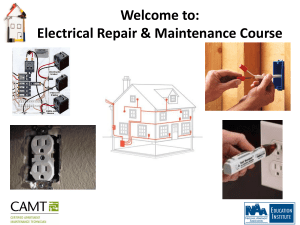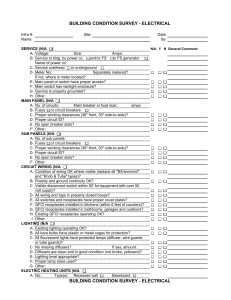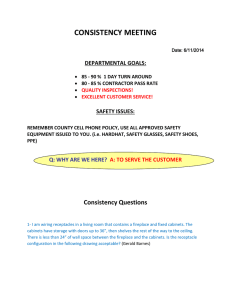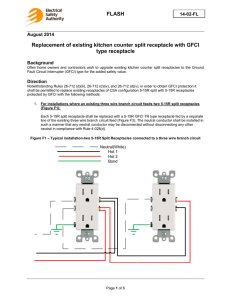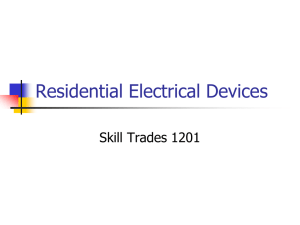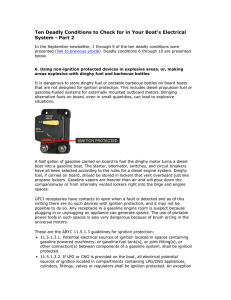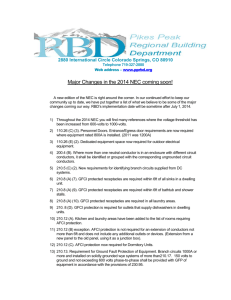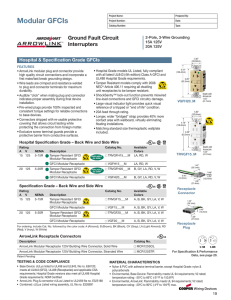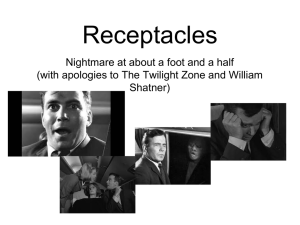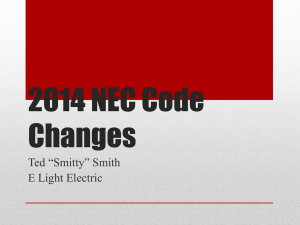GENERAL WIRING RULES FOR HOUSES
advertisement
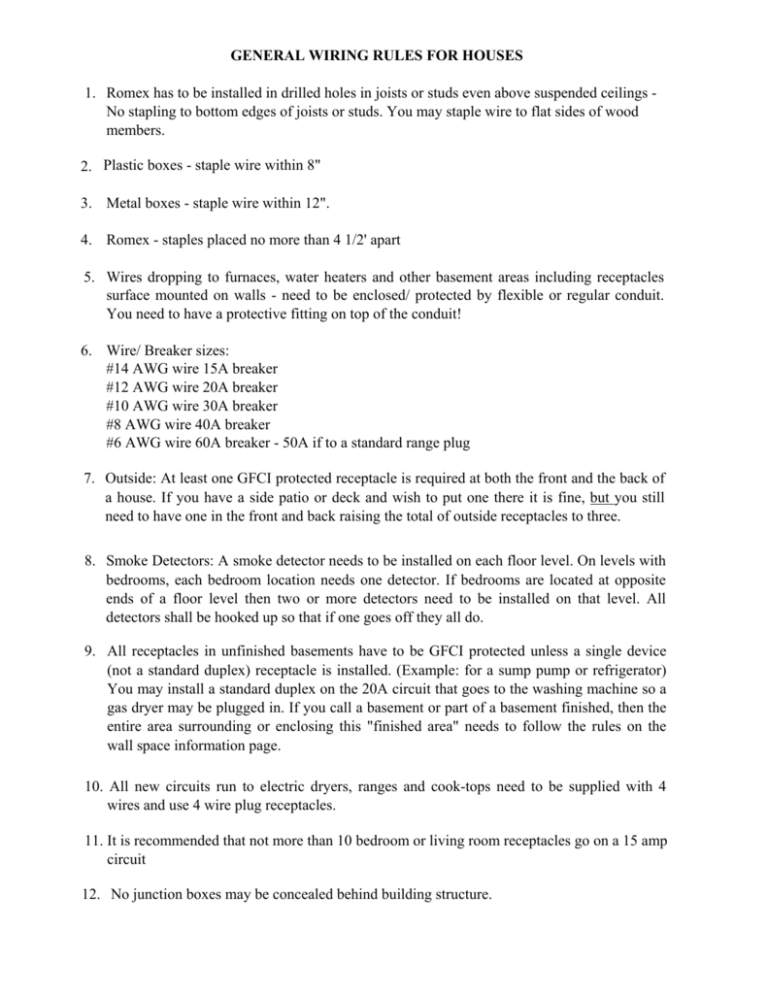
GENERAL WIRING RULES FOR HOUSES 1. Romex has to be installed in drilled holes in joists or studs even above suspended ceilings No stapling to bottom edges of joists or studs. You may staple wire to flat sides of wood members. 2. Plastic boxes - staple wire within 8" 3. Metal boxes - staple wire within 12". 4. Romex - staples placed no more than 4 1/2' apart 5. Wires dropping to furnaces, water heaters and other basement areas including receptacles surface mounted on walls - need to be enclosed/ protected by flexible or regular conduit. You need to have a protective fitting on top of the conduit! 6. Wire/ Breaker sizes: #14 AWG wire 15A breaker #12 AWG wire 20A breaker #10 AWG wire 30A breaker #8 AWG wire 40A breaker #6 AWG wire 60A breaker - 50A if to a standard range plug 7. Outside: At least one GFCI protected receptacle is required at both the front and the back of a house. If you have a side patio or deck and wish to put one there it is fine, but you still need to have one in the front and back raising the total of outside receptacles to three. 8. Smoke Detectors: A smoke detector needs to be installed on each floor level. On levels with bedrooms, each bedroom location needs one detector. If bedrooms are located at opposite ends of a floor level then two or more detectors need to be installed on that level. All detectors shall be hooked up so that if one goes off they all do. 9. All receptacles in unfinished basements have to be GFCI protected unless a single device (not a standard duplex) receptacle is installed. (Example: for a sump pump or refrigerator) You may install a standard duplex on the 20A circuit that goes to the washing machine so a gas dryer may be plugged in. If you call a basement or part of a basement finished, then the entire area surrounding or enclosing this "finished area" needs to follow the rules on the wall space information page. 10. All new circuits run to electric dryers, ranges and cook-tops need to be supplied with 4 wires and use 4 wire plug receptacles. 11. It is recommended that not more than 10 bedroom or living room receptacles go on a 15 amp circuit 12. No junction boxes may be concealed behind building structure. Wall Space A wall space is a wall unbroken along the floor line by doors, fireplaces, and similar openings. A wall space can include 2 or more walls and can be measured around corners. Any wall space 24" or wider requires a receptacle(s). First receptacle placement – no more than 6' from floor line breaks (doors, fireplaces, etc.) No more than 12' between receptacles. Hallways: 10' or longer require one receptacle. This 10' is measured along all center lines. Railings, balconies and half walls are considered wall spaces and require receptacles. A floor box receptacle may be required. KITCHENS NOTE: Counter top sections A through D are treated as individual counter tops for the purpose of determining the location of receptacles. See Section 210-52(c)(4). At least two 20 amp circuits sha11 supply the kitchen countertop receptacles. All receptacles for counter tops need to be GFCI protected no matter how far they are located from the sink. • separate 15 or 20 amp circuit is required for the refrigerator. • separate 15 or 20 amp circuit is required for a dishwasher with a switch to act as a disconnect either under the sink area or directly behind the dishwasher access panel. Instead of a switch the dishwasher may be cord and plug connected. This receptacle and plug may not be behind the dishwasher but it can be under the sink. A separate 15 or 20 amp circuit is required for a garbage disposal with a cord and plug in receptacle under the sink. Range hoods cannot be on the counter top circuits. It is recommended to have a separate 20-amp circuit for a microwave unit that has a dedicated space. No lights are allowed on kitchen receptacle circuits. 4 wire cable and plugs for electric ranges. You need to install a metal junction/receptacle box. Not a two gauge plastic box! I • • • • • • All ceiling light outlet boxes have to be rated for ceiling fans, even if a fan is not installed. These boxes are marked for this use. The only exceptions are bathrooms, hallways, closets, garages, and unfinished basements. Closet lights have to have totally enclosed bulbs, be at least 12" sanitary from any shelf or clothing or be a fluorescent type. Fluorescent lights have to be 6" or more away from the storage areas and can have open bulbs. All outside light fixtures have to have an electrical rated box behind them in or on the siding. The vinyl siding box is not a rated box. No lights are allowed on kitchen receptacle circuits. At each stairway a light needs to be installed. If this stairway has six or more steps then a separate switch needs to be installed at the bottom and the top to control this light. These switches would be separate from the lower level and upper level lights. Each outside "people" door of all homes and garages requires an outside light at the door location. This light has to be turned on with a switch. Required bathroom receptacle circuit - 20A Required laundry receptacle circuit - 20A Central Air Conditioners - The circuit breaker may only be as large as the label on the unit allows. (Example: Maximum CB - 25 amps) Whirlpool Tub Units - A separate circuit is required that is GFCI protected. Install a GFCI circuit breaker or a GFCI receptacle behind the unit's Pump access door. Indoor Hot Tubs & Spas - No receptacles or switches within 5' of water's edge. A GFCI protected receptacle is required within 10' of the water's edge. No ceiling fans or light fixtures within 5' of water (all directions) unless higher than 7'6" to top of water. Recessed fight fixtures rated for damp locations that have no metal trim and have a plastic or glass lens are permitted to be less than 7'6" to top of water if GFCI protected. These tub units have to be GFCI protected. Outdoor Hot Tubs, Spas or Pools Units need GFCI protection. No receptacles within 10' of water's edge except for one if needed to plug unit in. No switches within 5' of water. Check with the Electrical Inspector for clearances of overhead Aires or any lights in the area of these units!
